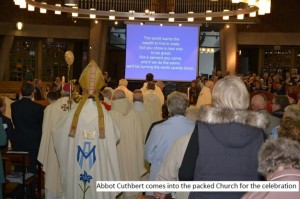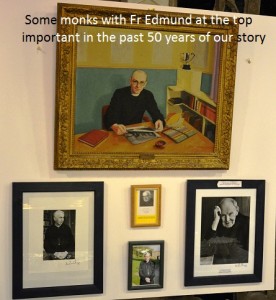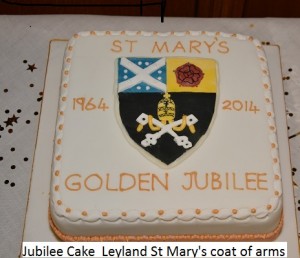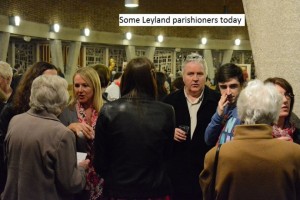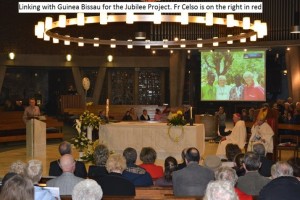On Friday 4th April 2014, about 450 people gathered to celebrate the exact day 50 years ago that our Church was opened by Archbishop Beck of Liverpool in the presence of a huge number of people. Both events were important milestones in the history of our parish which began in 1845.
In 1845, I wonder what those first monks, who came here to live from St. Mary’s, Bamber Bridge, or Brownedge parish, as it is affectionately called, had as their vision, when they founded the new ‘Leyland Mission’. I would suspect it was a practical idea that inspired them. There was a job to be done, a duty to be fulfilled, the conversion of England to the one, true Catholic faith. It is probable that the Leyland people had trudged, bravely, to Brownedge, Euxton or Brindle, in all kinds of weather, for Sunday mass. Now these good people deserved their own place of worship; at first, the Masses were said in the front room of the big red house on Worden Lane, next to the façade of our old Church. This was acquired by a famous Ampleforth monk, Fr. Brewer OSB, who was the Provincial of the Northern Province of the English Benedictines. The first church was later built and opened in 1865, on adjacent land to that house, and the parish was named St. Andrew’s parish. The parish later changed its patronage to St. Mary, because the Anglican Church across the road, also has Saint Andrew as its patron, this from medieval times. The little flock of Catholic farmers and workers were strong and stubborn in their beliefs, as they had endured centuries of persecution. As Frank Harrison says, in his history of St. Mary’s, Leyland, (p. 17): “The feelings of this congregation, the first over 300 years to hear Mass without fear in their own village can only be imagined.” It could have been from a sense of defensive co- existence with the “non-Catholics” that the parish of St. Mary’s Leyland was begun.
In 1964, Fr. Edmund FitzSimons, the parish priest with the vision and drive to see through the construction of the new building, presented his own ideas underlying our new Church. They too were practical. He himself made a balsa wood model of his initial idea of the Church: it was octagonal, about the same size as the present church, seating one thousand people and innovative. His ideas were clear: “there are two essentials for a church: that the people can see and they can hear what is going on”.
The problem in long, oblong, churches, the norm for cathedrals and large churches, people could hide behind pillars and go to the back where they gravitated by preference. Fr. FitzSimons designed the back seats to be eight rows from the altar, and with unrestricted viewing. He also made a prophetic statement when he said that he hoped posterity would benefit from his first venture into the world of architecture. He also said something else that gives an insight into his mind: “Just because a church is modern, there is no reason why it should not be made as beautiful as possible”. This has certainly happened, for the Church building has been considered the best modern Catholic Church in Britain – the conclusion of the new architecture competition, launched by the National Churches Trust, the Ecclesiastical Architects and Surveyors Association and the Twentieth Century Society. The final prizes were given in November 2013 at Lambeth Palace. In this competition, our own St. Mary’s was awarded the ‘Silver Medal’.
The reason for building in the early 1960’s was the rapid expansion in the population of Leyland – this in the midst of a Central Lancashire New Town development – and Father may have thought it probable that the Church could end up as a new cathedral, for a newly formed diocese. After all, when the English Congregation of Benedictine monks began again overseas, in the Low Countries, or France, in the early 17th. Century, the dream was that, in an England restored to Catholicism, Benedictines might again take over the cathedrals of England, as in medieval times. Those were heady, optimistic, days for the Catholic Church.
St Mary’s Leyland today can be truly grateful to God for his care for us as a parish in the past 50 years. His providence is quite exceptional for us. Let us take the economics of the parish: in 2012 we had no money with which to pay for a new heating system. By 2013 December it was installed, working well, and paid for. Since 1979 £1 million pounds has been spent on the parish and the Priory house making improvements, repairs and developments. A debt of £150K, and more, has been wiped out. At the same time, the generosity of parishioners to help the poor and the needy, has grown. Including all charitable giving, from schools and parish – together with one-off giving to good causes – we donated £30K a year, at least; and it’s not as though we have a massively expanding congregation. To know God’s Love for us, personally, as well as a community of faith, is an essential starting point to have faith in God and his Son Jesus Christ.
Question – what is the vision, presented to us, today, for St. Mary’s Leyland parish? An anniversary of the opening of a new Church is a good moment to reflect on it. Parishes are not just convenient groups of people, who happen to be Catholics, living in a certain locality. Rather, a parish is a divinely inspired group of people, who are the body of Christ, in a particular place; it continues to be: ‘the Church living the midst of the homes of her sons and daughters”. (John Paul 11 Christifideles Laici 26). According to Pope Francis, ‘the parish is not an outdated institution; precisely because it possesses great flexibility, it can assume quite different contours depending on the openness and missionary creativity of the pastor and the community.” (Evangelli Gaudium 28)
A parish is to be the presence of Christ Jesus in the local place. This implies the parishioners live out the Lord’s commandment, that he calls his own and new: “Love one another as I have loved you”. (John 13: 34). When parishioners truly attempt to do that, then they would, inevitably, find that they would: love the Lord their God with all their heart and with all their soul and with all their strength and with all their mind. (Luke 10: 27). It implies that the aim of parishioners should be warmly to welcome everyone, beginning with their fellow parishioners, and then everyone else; those who may or not be regular worshippers each Sunday at Mass, those who may not be living according to the normal rules of the Church, and those who do not know Jesus Christ and have rejected him. (see, Joy of the Gospel 15). Jesus’ own commandment does not imply that only Catholics, who are in the fullest communion with their church, can make his words their own. “Love one another as I have loved you”, does not put any particular restriction on those who can be included! It is just a very difficult ideal to achieve; eventually, it leads to the presence, locally, of Jesus among his people gathered in his name, (cf Mt 18:20) and that is impossible without divine intervention.
We hope to contribute up to £10K for the new Church desperately needed in Fr. Celso’s parish in Guinea Bissau, one of the poorest countries in the world.
Our Parish, in the particular context of Leyland St Mary’s, therefore, needs to provide a home that people can feel is theirs; parishioners must be outward-looking, even if only a minority of them form a small group of the population of Leyland; parishioners need to work with the other Christians of all denominations around them; parishioners need to be open to the poor of the area – and the poor outside our area; parishioners need to have an openness to believers of other faiths, and to non-believers who are people of good will.
We may, then, be in peace, leaving to God in his Son, Jesus Christ, who will be constantly alive among the people, if such a vision is accepted and real; we can be sure, he will assist us in the present to remain joyful and dedicated Catholic Christians, despite the ungodly context of England in which we live, and Jesus will lead us into the future to fulfil his plan for Leyland Parish and the Church as a whole.
Father Jonathan
